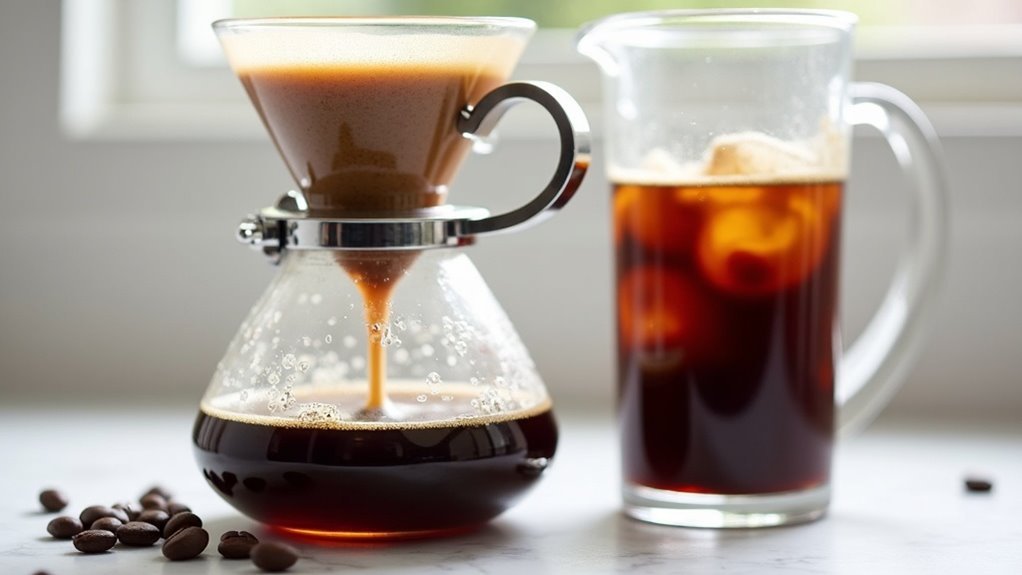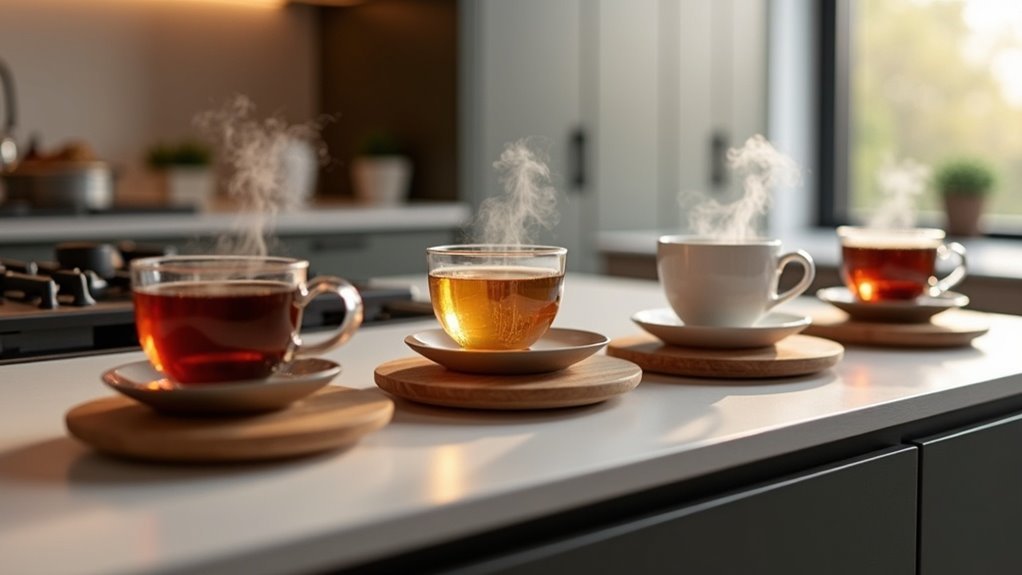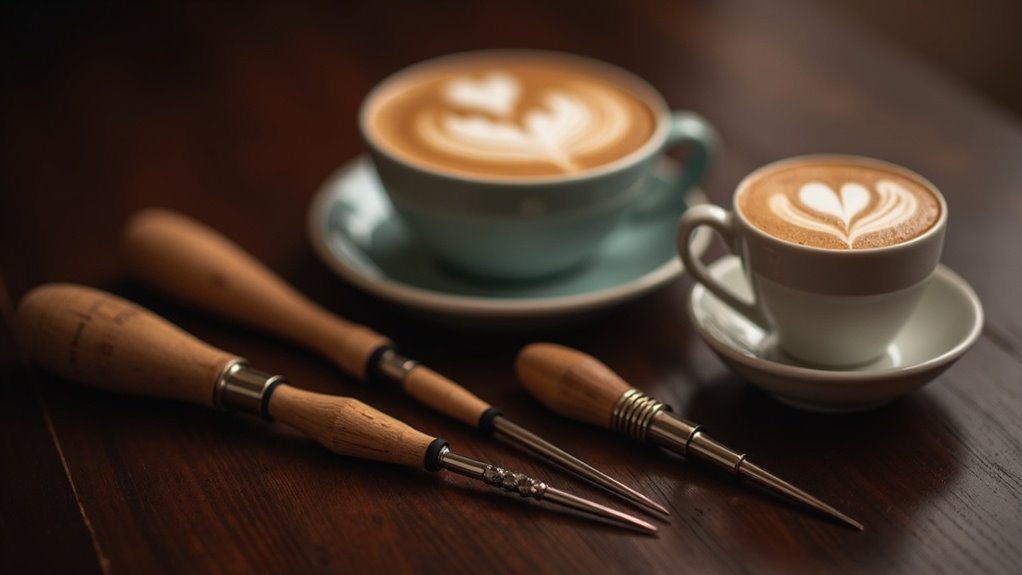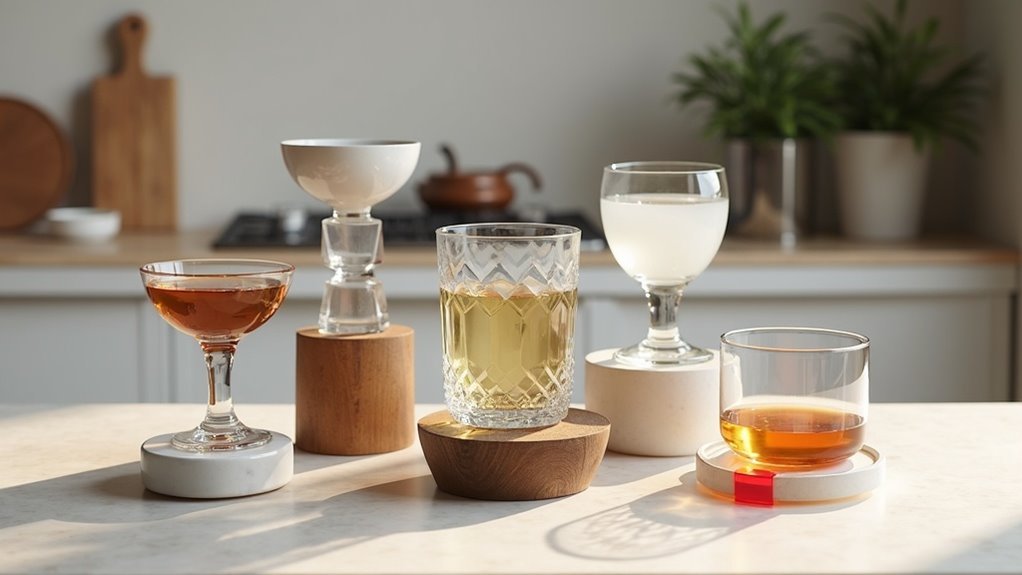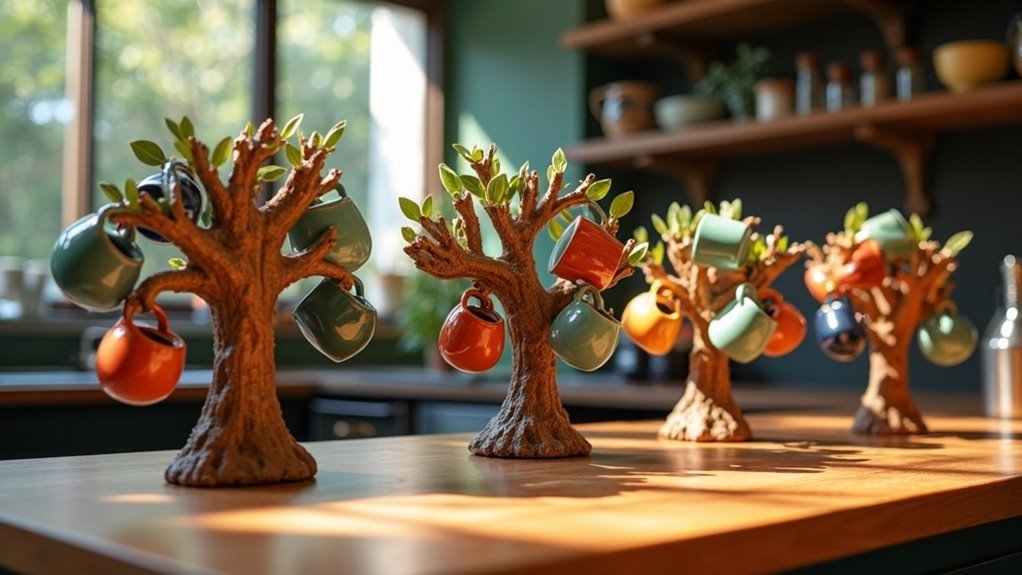Immersion cold brew involves steeping coarse coffee grounds in cold water for 12 to 24 hours, resulting in a smooth, less acidic concentrate. It’s a straightforward and budget-friendly method, making it perfect for coffee beginners. On the other hand, slow drip cold brew utilizes a specialized tower that allows water to drip over coffee grounds for 3 to 6 hours. This method produces a richer flavor profile and a slightly higher acidity. Ultimately, the choice between immersion and slow drip cold brew comes down to your brewing experience and flavor preferences. Explore the unique characteristics that distinguish these two brewing techniques in the world of coffee.
Key Takeaways
- Immersion cold brew involves steeping coarse coffee grounds in cold water for 12 to 18 hours, resulting in a smooth and low-acidity concentrate ideal for coffee lovers seeking a mellow flavor.
- Slow drip cold brew utilizes a specialized setup where water drips over coffee grounds for 3 to 6 hours, producing a richer and brighter flavor profile that appeals to those who enjoy a more complex cup.
- The immersion method is beginner-friendly and requires minimal equipment, making it accessible for new coffee enthusiasts, while slow drip demands a greater investment and a bit more attention to the brewing process.
- Flavor profiles differ significantly: immersion cold brew offers a sweeter, lighter body, whereas slow drip enhances acidity and floral notes, providing a vibrant and dynamic taste experience.
- Opt for immersion if you prefer simplicity and ease, or choose slow drip for a cleaner, more intricate flavor journey based on your coffee brewing preferences.
Immersion Cold Brew: The Basics
When you delve into immersion cold brew, you’ll discover that it entails steeping coarse coffee grounds in cold or ambient water for a period of 12 to 18 hours, yielding a rich and flavorful concentrate.
This immersion method streamlines the brewing process, requiring merely a brewing vessel, coffee filter, and cold water. Its forgiving nature makes it ideal for those new to cold brew coffee, allowing for experimentation without the need for precision.
The immersion method simplifies cold brew, making it perfect for beginners to experiment with ease.
Additionally, you have the flexibility to adjust batch sizes, whether you’re aiming for a small or large quantity.
The final product, often enjoyed diluted with water or ice, offers a smooth taste and lower acidity compared to traditionally brewed hot coffee.
The Brewing Process of Immersion Cold Brew
To brew immersion cold brew, you’ll need minimal equipment: coarse coffee grounds, cold water, and a straining device like a coffee filter.
The steeping time ranges from 12 to 24 hours, allowing for a rich extraction of flavor.
After steeping, you simply strain the mixture to separate the grounds, resulting in a versatile coffee concentrate that can be enjoyed on its own or diluted with water, milk, or a milk alternative for a refreshing coffee experience.
Equipment Needed
While you don’t need much to make immersion cold brew, having the right equipment can enhance your brewing experience. This method primarily requires a brewing vessel, such as a French press or glass jar, along with coarse coffee grounds and a coffee filter.
You’ll immerse the grounds in cold water, letting them steep for 12-18 hours. After steeping, strain the mixture to separate the grounds from the liquid, yielding a concentrated coffee.
This simplicity makes immersion cold brew accessible and budget-friendly, allowing you to easily adjust brewing time and coffee-to-water ratios to match your taste preferences.
Whether you’re a coffee enthusiast or a casual drinker, the right tools will elevate your cold brew experience.
Brewing Time
After gathering your equipment for immersion cold brew, understanding the brewing time is key to achieving the desired flavor profile.
Immersion brewing typically requires a brewing time of 12 to 18 hours, allowing for thorough extraction of flavors from coarse coffee grounds submerged in cold water. This extended steeping facilitates gentle extraction, producing a full-bodied, rich flavor compared to quicker brewing methods.
The forgiving nature of immersion cold brew makes it accessible for beginners, as there’s less pressure to fine-tune variables like grind size or drip rates.
Ultimately, the brewing time considerably influences the final concentrate’s taste and quality, making it an essential aspect of the coffee brewing process.
Straining Process
Once the brewing period for immersion cold brew is complete, straining the mixture is essential for achieving a smooth and flavorful concentrate.
The straining process separates the coffee grounds from the liquid, ensuring a full-bodied cold brew concentrate free from sediment.
- Use a coffee filter or fine mesh sieve for the initial straining to effectively catch the larger coffee grounds.
- For enhanced clarity and to reduce fine particles, consider using additional filters.
- Strain until you achieve a silky texture that elevates your cold brew drink.
- Dilute the concentrate with water or ice according to your preferred strength and flavor profile.
Master this straining process for a truly satisfying cold brew coffee experience.
Slow Drip Cold Brew: An Overview
Slow drip cold brew offers a unique brewing experience that emphasizes precision and flavor clarity, making it a favorite among coffee enthusiasts.
This method utilizes a specialized brewing device, often called a drip tower, which slowly drips water over coffee grounds for a period of 3 to 6 hours, enhancing the extraction of flavors.
The adjustable drip rate allows you to influence the brew’s final balance, sweetness, and acidity, resulting in a lighter, brighter flavor profile.
While slow drip cold brew yields high caffeine content and low acidity, it requires more attention and investment, making it less user-friendly for beginners who may prefer a more straightforward brewing process.
The Brewing Process of Slow Drip Cold Brew
The brewing process of slow drip cold brew is characterized by its careful approach to flavor extraction, making it a favorite among coffee enthusiasts.
Using a drip tower, ice-cold water slowly drips over coffee grounds, allowing for an optimal extraction process that typically takes between 3 to 6 hours.
Here are some key aspects to keep in mind when brewing your cold brew:
- Adjusting the drip rate precisely is crucial for achieving the best extraction.
- Longer brewing times can enhance the complexity of your coffee’s flavor profile.
- This method effectively minimizes oxidation, helping to preserve the freshness of your brew.
- Slow drip cold brew often results in a lighter, brighter flavor compared to traditional immersion methods.
Flavor Profiles: Immersion vs. Slow Drip
While both immersion and slow drip cold brew methods yield unique flavor profiles, understanding their differences can significantly enhance your coffee experience. Immersion cold brew typically offers a smoother, sweeter flavor with a lighter body, making it an excellent choice for those who prefer a mellow coffee experience. In contrast, slow drip coffee delivers a richer, heavier taste with enhanced brightness, appealing to those who enjoy a more robust flavor.
The extraction process plays a crucial role in these flavor profiles. Slow drip retains more acidity and floral notes, resulting in a vibrant cup of coffee. This distinction is important for coffee enthusiasts looking to explore the nuances of their brew.
| Method | Flavor Profile | Acidity |
|---|---|---|
| Immersion Cold Brew | Smooth, sweet, lighter | Lower acidity |
| Slow Drip Coffee | Rich, complex, vibrant | Higher acidity |
| Overall Experience | Full-bodied concentrate | Balanced, bright flavors |
Understanding these differences allows you to select the brewing method that best suits your taste preferences, ultimately elevating your coffee-drinking experience.
Choosing the Right Method for You
How do you decide between immersion cold brew and slow drip methods? Consider your experience level, taste preferences, and brewing goals.
- Immersion cold brew is ideal for beginners, providing a simple, hands-off approach that results in a full-bodied concentrate.
- Slow drip cold brew is designed for more experienced home brewers, offering a cleaner flavor profile that emphasizes the unique characteristics of the coffee.
Reflect on your desired coffee extraction; are you seeking versatility or complexity in your brew?
Budget is also a consideration; immersion cold brew requires minimal equipment, while slow drip may necessitate specialized tools.
Choose the method that best fits your lifestyle and coffee aspirations to enhance your brewing experience.
